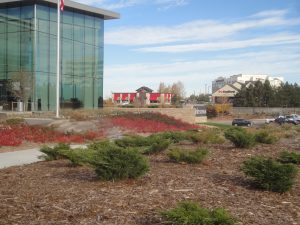The term ‘sustainable’ is everywhere, but what does it mean to our landscapes? The common perception is that sustainability in the landscape means drought resistant spaces that require little or no additional water, which are maintained with an unkempt aesthetic and mulched with rock. This is completely inaccurate. Sustainable landscapes get a bad rap because they are often installed improperly, and almost always misunderstood. There is a much more meaningful, and appealing approach to sustainable landscaping that is generally unknown.
So what are the main characteristics of a proper sustainable landscape? 
Sustainable landscapes are planned as complex ecosystems. Similar to nature, sustainable landscapes (also called regenerative landscapes) consider even the smallest niches to ensure the health and function of the complete system. These considerations start at the soil, move through the plant canopy and touch everything in between.
While they do generally require less water than a traditional landscape, the reality is more nuanced. They are designed with specific features and species that are able to thrive in the ecosystem in which they are placed. We have all seen soggy spots and dry spots in our own yards. Sustainable landscapes address these features as separate microclimates that require different materials. The soggy spots would house plants that require more water, while the dry spots would be populated with species acclimated to more arid conditions.
Soil Health
Sustainable landscapes place a high priority on soil health. Without healthy soil you cannot have a healthy ecosystem. Regenerative landscapes add organic matter and soil biology to the soil. Critters like bacteria, fungi and other microbial creatures are the most important part of the soil. These creatures and the soil they create are the “immune system” of the planet. Regenerative landscapes passively build soil health as they mature, strengthening the entire system.
Nat ive Plants
ive Plants
Native plant species are another big part of regenerative landscapes. Natives are perfectly adapted to local conditions like precipitation, temperatures, pests and seasonal changes. If natives don’t pack enough punch for your space, many great cultivars have been developed for superior color and foliage displays.
What can sustainable landscapes be?
Sustainable landscapes can be anything. They can carry almost any aesthetic; natural and wild looking, or clean and compartmentalized. -Even with the same plant palette. They can display blocks of color, or show off muted textures. Turf can also be installed and maintained sustainably. Harvard Yard has been doing it that way for years!
The quickest way to build a truly sustainable landscape is to start from the beginning, but with enough foresight and thought, existing landscapes can be transitioned to a regenerative space.
Pockets can be carved out of a commercial landscape to keep the budget under control, or entire campuses can be transitioned to make a bold statement to your clients and your employees.
If you need direction for your regenerative landscape, reach out. Let’s see what Terracare Associates and your organization can build together.
